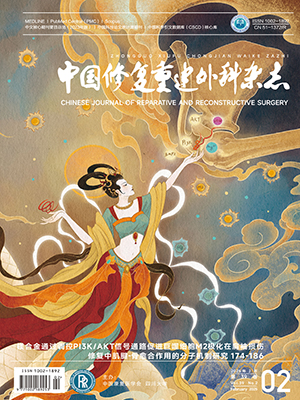Objective To compare the effectiveness between minimally invasive cannulated screw and open reduction and plate fixation in treatment of humeral greater tuberosity fracture by a prospective case-control study. Methods Between January 2008 and January 2011, 49 cases of humeral greater tuberosity fractures were treated with minimally invasive cannulated screw in 25 cases (trial group), and with open reduction and plate fixation in 24 cases (control group). There was no significant difference in gender, age, injury cause, disease duration, fracture displacement, injury side, and complications between 2 groups (P gt; 0.05). The length of incision, operation time, intraoperative blood loss, and hospitalization days were recorded. According to Neer grading system, the effectiveness was evaluated; fracture healing was observed by X-ray films. Results The trial group had smaller incision, shorter operation time, less blood loss, and shorter hospitalization days than the control group, showing significant differences (P lt; 0.01). Superficial infection occurred in 2 cases of the control group, and were cured after symptomatic treatment; primary healing of incision was obtained in the others of 2 groups. All patients were followed up 1-4 years (mean, 2.3 years). The fracture healing time was (7.0 ± 2.3) weeks in the trial group, and was (7.8 ± 2.1) weeks in the control group, showing no significant difference (t=1.24, P=0.22). No heterotopic ossification or loosening and breakage of internal fixation occurred during follow-up. The shoulder function Neer score of the trial group (86.3 ± 2.8) was significantly higher than that of the control group (80.1 ± 2.1) (t=6.37, P=0.00). The results were excellent in 14 cases, good in 8 cases, fair in 2 cases, and poor in 1 case with an excellent and good rate of 88.0% in the trial group; the results were excellent in 12 cases, good in 7 cases, fair in 2 cases, and poor in 3 cases with an excellent and good rate of 79.2% in the control group; and difference had no statistical significance (Z=0.83, P=0.41). Conclusion Compared with open reduction and plate fixation, minimally invasive cannulated screw for greater tuberosity fracture has the advantages of simple operation, less trauma, less intraoperative blood loss, and good shoulder function recovery.
Citation: CAO Liehu,WENG Weizong,SONG Shaojun,LI Haihang,SU Jiacan.. COMPARISON OF EFFECTIVENESS BETWEEN MINIMALLY INVASIVE CANNULATED SCREW AND OPEN REDUCTION AND PLATE FIXATION IN TREATMENT OF HUMERAL GREATER TUBEROSITY FRACTURE. Chinese Journal of Reparative and Reconstructive Surgery, 2013, 27(4): 418-422. doi: 10.7507/1002-1892.20130097 Copy
Copyright © the editorial department of Chinese Journal of Reparative and Reconstructive Surgery of West China Medical Publisher. All rights reserved




